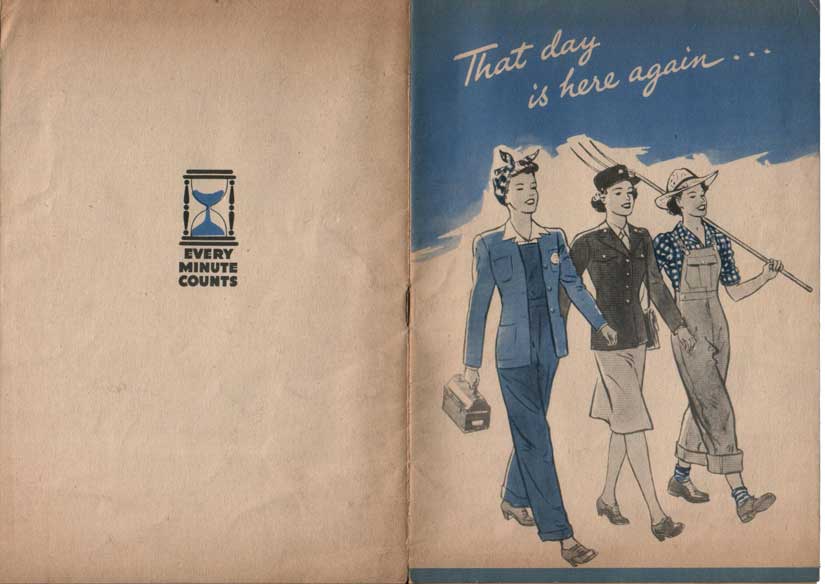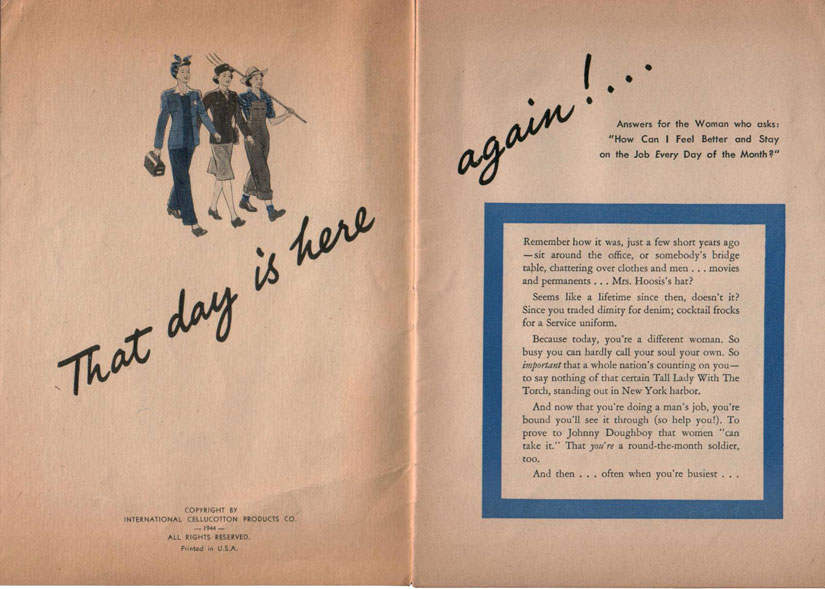The style of the booklet is similar to the 1940 Kotex As One Girl to Another.
Marjorie May, three booklets, 1935
main page
 
|
 
That day is here again . . . ,World War
II menstruation booklet from
Kotex sanitary napkins, 1944, U.S.A.
World War II transformed America, pulling it out of the Depression,
sending record numbers of people to college afterwards, and making women
more part of the world outside the home.
Unlike the Iraq war, that war forced Americans to conserve everything
from food to steel.
And women filled many jobs that had been left by the soldiers fighting
overseas.
"That day is here again . . ." brilliantly shows many of these
changes spiraling around rock-steady menstruation, a given in women's lives.
That day, of course, is the menstrual period (see more
such expressions).
The booklet's illustrator appears to be one of the those for the "Are you in the know?" ads Kotex made then and
for years afterwards. The snappy text reflects the ads that give amusing
insight into the era's slang. The chisel-point writing enhances the informality.
But the concerns addressed are those of women today even though the solutions
can be different. (See more Kotex war-theme ads: 1943,
1944 and here.)
One of the booklet's predecessors, As One Girl
to Another (1940), probably pioneered the casual, upbeat tone characteristic
of the ads, replacing the stiff Margaret May series
of booklets for girls.
After the war Walt Disney made a film,
The Story of Menstruation, for schools, maybe the first of its kind.
You see only white
people here, a phenomenon lasting till almost
today in America (this booklet
was possibly one of the first with nonwhites). Part of the reason may have
been money; blacks in general earned less than whites, and probably were
more likely to use washable rags than the fairly expensive Kotex. This was
towards the end of the Depression.
I thank the Dutch contributor of many items
to this site for these scans and his comments!
|
Below: Back (at left) and front covers.
Each page measures 13.6 x 19.5 centimeters (about 5 3/8 x 7 3/4").
Note the ONE staple holding the booklet
together. The Dutch contributor suggests, I'm sure correctly, that this
was to save metal that could be used more directly for the war. The Kotex
booklet from 1940, before America entered the war, had two
staples.
At right, EVERY MINUTE COUNTS happens to
be the name of a film from the year of this
booklet. "This film was produced to heighten productivity in civilian
home front industries during World War II. Aimed at employers and workers
alike, it shows problems faced by some workers (especially
working women) in balancing home and family duties against the necessity
to report to work on time and work regular hours," writes Internet
Archive (http://www.archive.org/details/EveryMin1944), where you can see
it.
The contrast is huge between the extraordinary public effort (encouraged
by the government) in World War II and what is required of the average American
today with the war in Iraq: zero.
|
|
 |
Below: Inside front cover and facing page.
Readers today might be amazed at the language and appeal to patriotism
as well as the push to do a good job in replacing the absent men and women
at war. Especially the men, "Johnny Doughboy," which sounds like
a World War I expression. This war, World War II, created the conditions
for women to massively enter the work force in America by replacing the
missing men. It also helped sell tampons, which were less cumbersome than
pads. Kotex made both - see here - but the victor
was probably Tampax, the most famous tampon even
today.
|
 |
|
|
Copyright 2007 Harry Finley
|
|
|